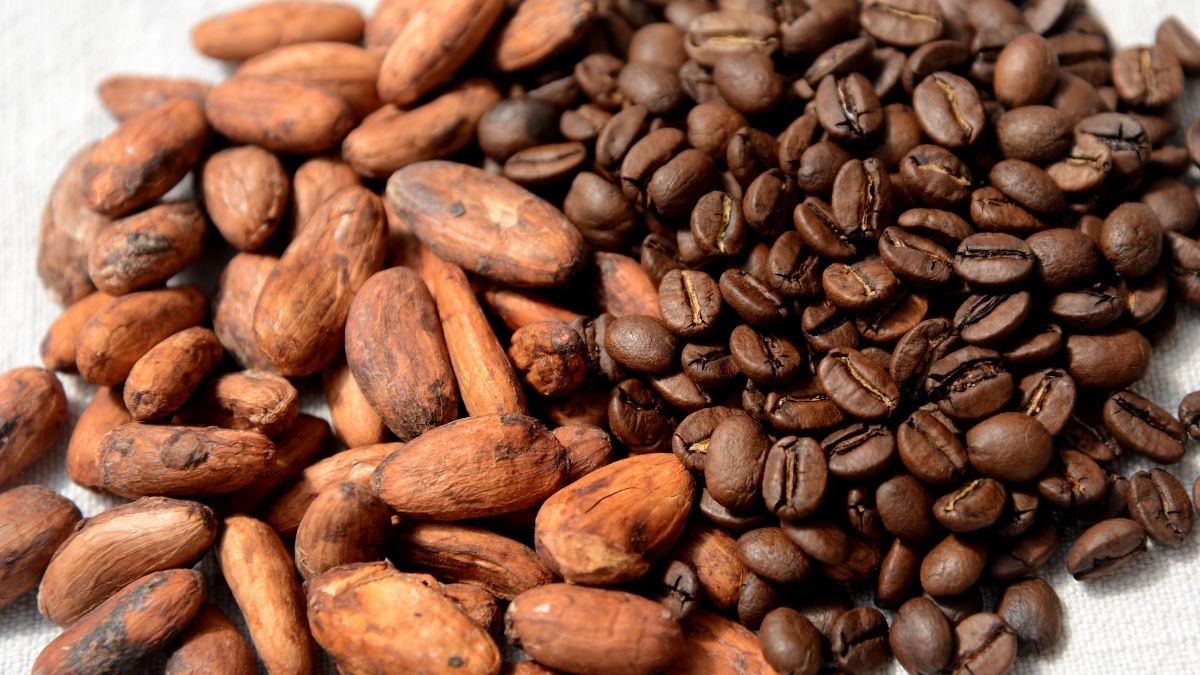Coffee. Cocoa. Ah, both are equally good when made to perfection. Espresso, latte, cappuccino, or chocolate and choco-based drinks are what we’re living for. These are made from coffee beans and cocoa beans. But what’s the difference?
Coffee beans and cocoa beans, in their strictest sense, aren’t actually beans. They come from the seeds of the coffee red berries plant and cocoa pod, respectively. Coffee beans are used to make caffeinated drinks that are stapled to almost everyone’s diet. Cocoa beans are used to make chocolates, cocoa powder, and many different drinks. These are less dense compared to coffee beans because of the former’s fat content.
These fascinating facts and more about cocoa beans and coffee beans will be tackled throughout this article. Let’s keep moving, shall we?
Cocoa Beans
Cocoa beans also called cacao, come from the cacao tree, a native to the Amazon rainforest. More than 5,000 years ago, cacao was first domesticated in South America and was then cultivated in Central America over a thousand years later. The cacao tree also grows at the foot of the Andes Mountains.
Swedish scientist Carl Linnaeus first gave cacao its botanical name Theobroma Cacao meaning “Food of the Gods.” Cocoa is from the Spanish word cacao that derived from cacahuatl, a Nahuatl word from ancient Central Mexico. It became a commodity in the Mesoamerican region comprising Honduras, where the ancient tribes, including the Mayan and Aztec, were believed to be the first to consume cocoa.
The Spanish Conquistadores then introduced cocoa to the Philippines, and West Indies, then to Asia and the Pacific region.
The cocoa plant has three varieties:
- Forastero. This has the most worldwide usage ranging from 80% to 90% of production.
- Criollo. There have been a few producers of Criollo due to its less resistance to diseases that destroy the cocoa plant.
- Trinitario. This one is hybrid, and with greater quality than Forastero. It’s also more resistant to diseases than Criollo.
Coffee Beans
Also called stone fruit like the regular cherries, coffee beans are the bean-like seeds inside the red, sometimes purple fruits of the coffea plant, the source of coffee that we consume daily. Some coffee beans would only contain one seed, which is unusual for the common two stones that we always see. These are called peaberries, which are believed to be more flavorful than the normal beans.
The history of coffee is unclear, but some believed that Kaldi, a goat herder in Ethiopia discovered coffee after his goats’ intense physical movements when they ate coffee beans. Others also said that the very first coffee plant was discovered in the Yemen mountains. Some discoveries were in India, Europe, Java, the Caribbean, South America, and Dutch East Indies.
Coffee is said to have gotten its name from the Dutch word koffie, kahveh of Turkish term, and qahwah of the Arabic word, which we have covered in this article. But it’s said that the name coffee got it from the most popular legend where the coffee plant believed to be first discovered in Kaffa Province, Ethiopia. Thanks to Kaldi, the goat herder!
The coffee plant has a few species:
- Arabica. This’s the most widely produced coffee variety in the world with 60% production.
- Robusta. It’s next to Arabica with 40% worldwide production, including Vietnam as the highest producer of Robusta with species originating from Indonesia and the Philippines. Both Arabica and Robusta are widely used around the world.
- Liberica/Excelsa. Liberica’s variety was first known in the Philippines, called Café Baraco or Kapeng Barako. Excelsa, on the other hand, is known in Southeast Asia.
- Coffea Charrieriana. This was first discovered in Cameroon, which is caffeine-free.
- Coffea Stenophylla. In Sierra Leone, this variety is said to have the ability to grow at high temperatures compared to Arabica with a better flavor than Robusta.
- Hybrids. There are varieties of some coffee species like the Arabica and Robusta grown in Ethiopia, and Nicaragua.
Cultivation, Harvest, And Production
Coffee Beans
Select green coffee beans are typically cultivated in fertile soil in a large bed, watered frequently, and kept in nurseries away from bright sunlight until they’re strong enough to be planted. Germination will take at least 30 to 40 days before the seeds are considered substantial for permanent planting. The coffee plant, depending on the variety, takes four to five years to bear the fruit or the beans.
After a maximum of five years, the plant will then bear fruit called coffee cherries that turn into deep red and are considered ready for harvest. The beans are harvested either by strip picking or selective picking.
Strip picking can either by hand or a machine where all the beans are removed from the limb. Selective picking is considered more laborious since only the cherries in their ripest state are picked to produce the highest quality of coffee. However, the beans that were strip-picked can undergo extensive sorting to improve the quality of production.
The beans are immediately processed soon after they’re picked to avoid getting them spoiled. During the production, the coffee beans are dried out first under the sun. This is called the dry method. The beans must be spread out, raked, and turned throughout the time that they’re drying out to prevent spoiling.
Drying out the beans takes weeks to finish until their moisture level drops to 11%. This method though is considered old school although there are still a lot of countries that use this as it doesn’t require a huge amount of water.
On the other hand, some coffee producers use the wet method, which uses a machine that separates the pulp and skin from the beans. The beans then go through weight separation, water-filled fermentation tanks, and water channels before they’re ready for drying.
The dried coffee beans are then milled where they undergo hulling, polishing, grading, and sorting before they get exported. They then get tested to ensure quality and taste. After a series of tests, the beans are prepared for roasting, grinding, and brewing. That’s what happens to your cup of joe!
Cocoa Beans
Just like the coffee beans, cocoa seeds are cultivated in shaded nursery beds and should be treated with lime or ash. As soon as they grow at least 60 cm, they’re ready to be transplanted. These must be irrigated properly during the summer season as they’re sensitive to dryness.
Farmers also use organic fertilizers and manures to grow the cacao tree. They also undergo the pruning process to ensure that they get direct sunlight and are not being dominated by their dead or old branches or stems.
The cacao tree takes four to five years to bear fruit of up to 70 pods each year. These cocoa pods are ready for harvest in five to six months or usually when green pods turn yellow. Each pod yields 30 to 35 cocoa beans.
After a week or up to ten days from harvest, the pods are then manually opened using a cutting tool to take the wet pods out. These pods go through fermentation. where they’re piled and covered with banana leaves. This process allows micro-organism buildups such as yeasts or bacteria that grow around the cocoa beans.
With high temperatures, a chemical reaction starts to break down the cell walls of the cocoa beans where they slowly get die out. These chemical changes cause the cocoa beans to produce chocolate flavor as well as a change in color. According to the International Cocoa Organization (ICCO), fermentation depends on the variety of cocoa beans. Criollo takes two to three days whiles Forastero takes five days.
To reduce the moisture level of the beans from 60% to at least 7.5%, they must be dried out either through artificial drying or sun drying. The former needs wood and fuel while the latter must be carried out manually.
The drying process should be done carefully that it shouldn’t be too fast or too slow. If it’s too fast, the beans become acidic and produce a bitter taste. When too slow, off-taste and molds develop. During the drying process, temperatures should not be more than 65ºC.
When the cocoa beans are dried out, they’re stored in sacks for aging, which takes 30 days to a year depending on the variety of the beans. This process must be done carefully as well so the beans don’t buildup moisture.
After the aging process, the beans are now ready for roasting with careful monitoring of their density and moisture levels. Cocoa roasters would set the temperature between 110ºc and 116ºc if they want to produce floral and fruity notes. With a deeper or bolder taste with a hint of caramel, roasters set the temperature anywhere between 130ºc and 135ºc depending on the variety of the beans used.
Endnotes
Both coffee and cocoa beans go through a careful process before they end up in your cup. From cultivation to roasting and brewing, coffee beans and cocoa beans differ although they both provide us amazing health benefits when consumed in moderation.
So are you a coffee person, or are you more of a chocolatey guy?

